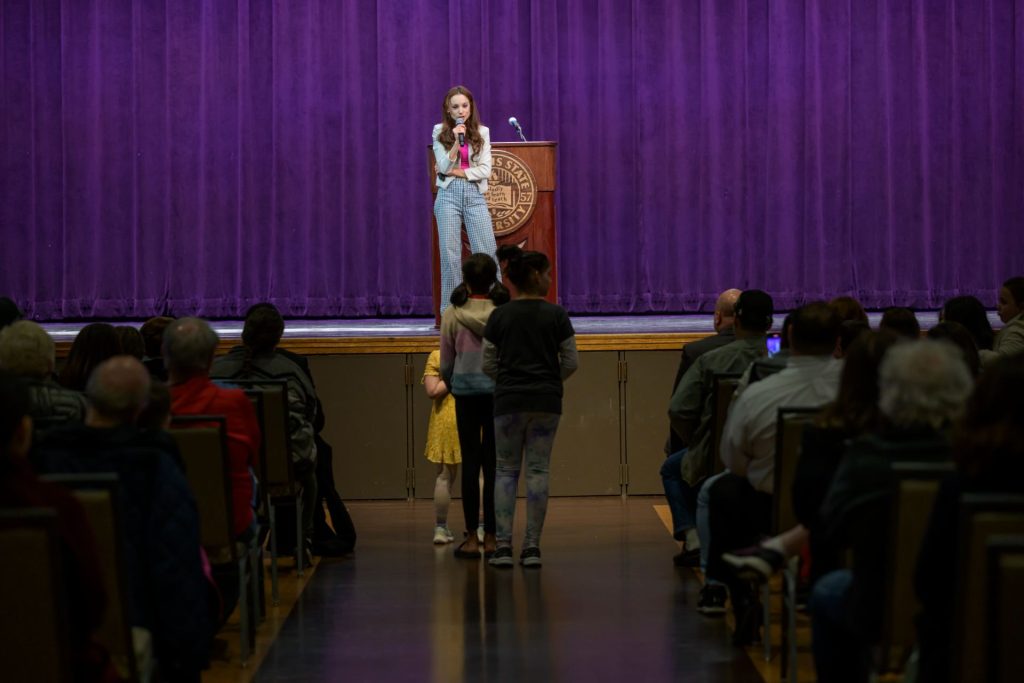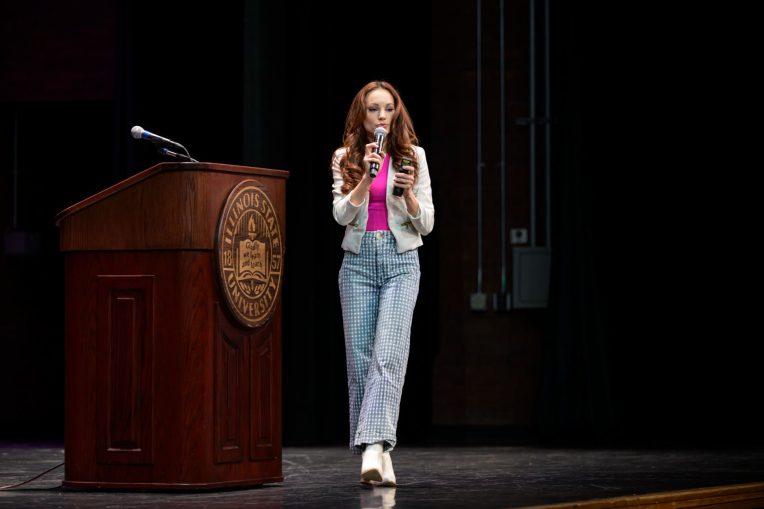Emily Calandrelli, known to her fans as “the space gal” and as the host and co-executive producer of Emily’s Wonder Lab series on Netflix, delivered the keynote address for Illinois State University’s 2023 Science and Technology Week on March 28 in the Bone Student Center’s Brown Ballroom.
An aerospace engineer and acclaimed author, Calandrelli’s mission is to spread the word about the importance of women and diversity in the fields of science, technology, engineering, and mathematics (STEM).
Calandrelli said diversity and looking at challenges from all angles are the keys to being innovative. The way to inspire more kids to pursue STEM educations and careers, she said, is for them to see representations of themselves in the people doing those things. Another way is to make kids feel more welcome in STEM.
“People want to go where they’re celebrated, not where they’re tolerated,” she said.
She offered several real-world examples where inefficiencies have occurred because STEM teams lacked diversity.
“I didn’t find science until high school. If it takes a little longer, it’s OK. I still ended up at MIT.”
Emily Calandrelli
Office temperatures around the world are generally cold because they are based on a formula of the average man’s metabolic resting rate, she said. Women’s restrooms often have long lines because the designing engineers and architects were men who allocated the same number of toilets for men’s and women’s spaces. But men have stalls plus urinals, and Calandrelli said women generally take more time and often have children with them. In addition, more elderly and disabled people are women.
“Equitable is not equal,” Calandrelli said. “How might bathrooms look if more women were in the room when they were designed?”
Soap dispensers with sensors don’t always work as well for people of color because they were tested on light-skinned engineers. In the medical industry, clinical drug trials are often done on men only, so recent studies show that women are twice as likely to experience adverse drug effects.
The U.S. didn’t require that car crash safety tests use female car test dummies until 2011. Women, as a result, haven’t been as protected.
“We have different muscle mass distribution, different bone density, different vertebrae spacing, better hair, better fashion sense,” she said. “And all of that, most of that, it impacts the way that we are injured in a car crash.”
“At best, it’s just annoying and inefficient,” she said. “But at worst, it’s costing our health, and it can be deadly.”
Even NASA engineers don’t always get it right, she said. When NASA sent the first woman into space, astronaut Sally Ride, the engineering team asked her if 100 tampons would be enough for a six-day mission.
“For those of you in the audience who haven’t had the joy of experiencing a period, that number is too high,” Calandrelli said.
A native of West Virginia, Calandrelli earned bachelor’s degrees in mechanical and aerospace engineering from West Virginia University. She has two master’s degrees, one in aeronautics and astronautics and one in technology and policy, from the Massachusetts Institute of Technology (MIT).

Among her many gifts is her ability to communicate with audiences of all ages. She calls herself a “science communicator.” Her enthusiasm for her subject was apparent as was her affection for her Brown Ballroom audience, many of whom were female and under the age of 10.
“This was not the career I expected for myself,” Calandrelli admitted.
She was the first person in her family to pursue a STEM-related college degree, and she did so by accident. Wanting to escape a family legacy of poverty that her father had broken out of, she researched careers that paid the best, which led her to engineering.
“I was surprised that I fell in love with science,” she said. “I became obsessed with it. I can’t stop talking about it.”
She has a passion for space and the space industry and covers it on social media. She said this is a time of renaissance for the industry. Despite much of the news being about billionaires—think Bezos, Branson, and Musk—she said there is a deeper meaning. She hopes this era will see barriers broken for women and people of color who have ambition to go to space. Currently, of the 600 or so people who have gone to space, she said, they are all remarkably similar.
“They are mostly men, they are mostly white, they are mostly American, they are mostly scientists, engineers, and pilots,” she said.
In the last two years, space tourism companies have opened things up to more people.
“They’ve sent the first Mexican-born woman into space, the second Indian-born woman, the first Egyptian into space, the oldest person into space, the youngest person into space,” she said. “William Shatner into space.”
NASA’s Artemis 1 launch last fall brought her joyful tears watching it live, she said, for similar reasons. She plans to watch future launches with her daughter.
“She’s going to be able to see a woman step foot on the moon,” Calandrelli said. “More people in the United States are going to be able to see somebody who looks like them step foot on the moon. How is that going to change the way that they view themselves?”
She remains concerned about the gender gap in STEM noting that 57% of women make up the U.S. workforce, but only 29% of STEM jobs.
“While we have made great strides, we still have a long way to go,” she said.
She said not to be concerned about failure or if things come later in life than you planned.
“I didn’t find science until high school,” she said. “If it takes a little longer, it’s OK. I still ended up at MIT.”
She finished by saying that life’s challenges can be daunting and scary.
“You will find the power of your own voice and you will find the power of working together,” she said. “Because a lot of these problems are easier solved when you work together with friends to solve them.”

